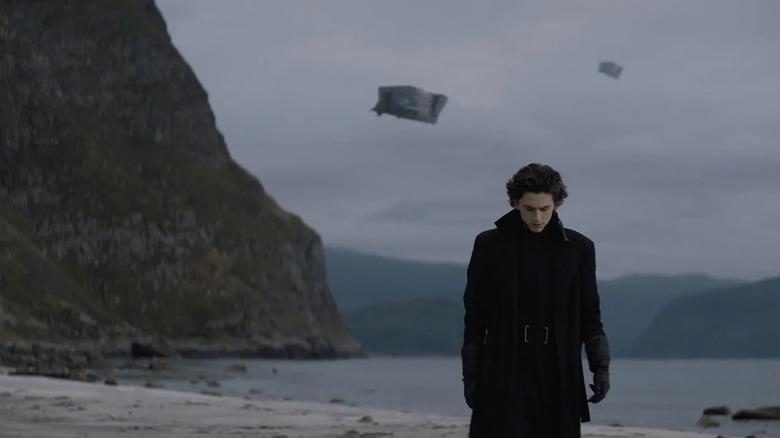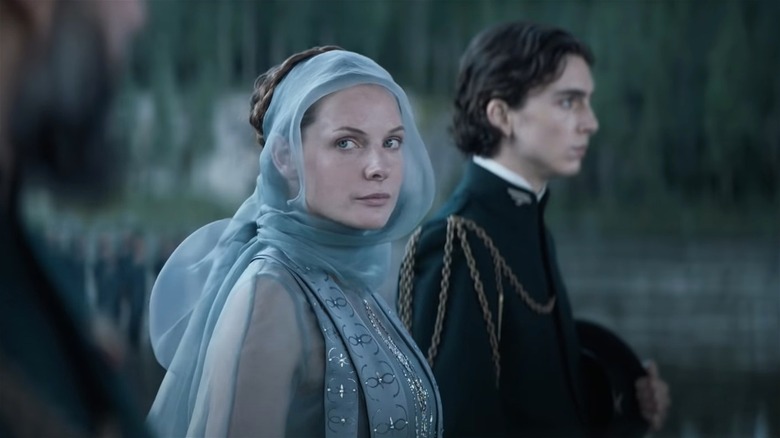The Famous Real-World House That Inspired Dune's Castle Caladan
Compared to most planets in the Known Universe in Frank Herbert's "Dune" saga, the lush oceanic planet of Caladan feels like paradise. The environmental facets of this bountiful planet are often used to evoke sharp contrasts with Giedi Prime or Arrakis, as the latter feature rough terrains and near-inhospitable conditions that have shaped its inhabitants for millennia. While Giedi Prime is a bleak, hyper-industrialist dystopia, the dunes of Arrakis challenge every invader staking a claim on the planet's resources, its sacred secrets only privy to the mysterious Fremen. In stark contrast to these harsh environments, Caladan has always been associated with a flourishing economy and general prosperity, its overabundance of water emerging as a mythic dream to those who view it as a luxury instead of a necessity.
Castle Caladan is the nexus of Paul Atreides' home planet; it is an enduring symbol of the Atreides stronghold, whose rule spanned over 10,000 years under the order of the Imperium. After House Atreides was ordered to take over Arrakis from the Harkonnen regime, an interim ruler was appointed to rule Caladan in their stead, although the military forces and the civilians left behind were still fiercely loyal to the Atreides banner. As Caladan's economy and socio-cultural status are directly influenced by the planet's natural bounty, "Dune" production designer Patrice Vermette conceptualized Castle Caladan as a honeycombed structure resembling a beehive.
"Dune" has always been about humanity's attempts to integrate into nature — no matter how harsh or unwelcoming it might be — and the repercussions of disturbing natural equilibrium due to unchecked human ambition. Per Tanya Lapointe's "The Art and Soul of Dune," Vermette focused on integrating natural and human existence in the castle's design process, where the two aspects overlap to evoke sustainable adaptability. How did these design elements come together?
Denis Villeneuve links art with reality in Dune
According to Lapointe's book, the hexagonal shapes that make up Castle Caladan form a "pattern language" that can be linked directly to the history and motivations of the Atreides. Vermette stated that these beehive patterns "stack well together" where "by integrating the castle into a mountain" they could denote that "the Atreides are trying to blend in with nature. It's like Frank Lloyd Wright's Fallingwater house, melding with the environment." This balanced cohesion between nature and humanity is reflected in the planet's underwater ecosystem that nourishes its inhabitants, explaining why the society is largely geared towards agriculture, with a focus on grains and wines. As Caladan is an oceanic planet, fishing is also a seminal part of the people's culture, which flourished as an industry under the Atreides rule.
Vermette had initially designed Castle Caladan, the cornerstone of the landscape, as a group of separate buildings on an isolated cliffside, but director Denis Villeneuve felt that this did not sync with how closely Caladan was linked with House Atreides, and the concept design was later changed. The unified honeycomb structure represented authority, cohesion, and unity, and Villeneuve used this concept art to structure the scenes set on the oceanic planet to the finest details. "I'm always trying to link movies with reality. I try to create an equilibrium between familiarity and strangeness," the director explained.
The nostalgic image of rain falling from the skies of Caladan is a recurring motif in the "Dune" novels, as this abundance is an impossibility on Arrakis (where the Fremen view moisture as sacred, as every drop is precious). With every step into the heart of the desert, we move further away from Caladan's lush beauty, to a point that the oceanic planet feels like a distant dream.

